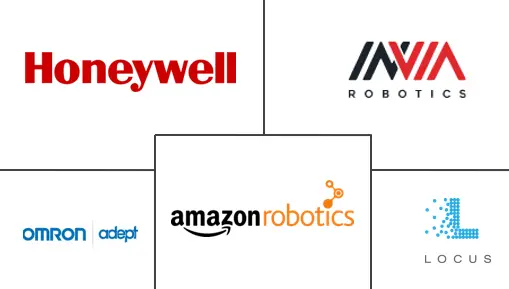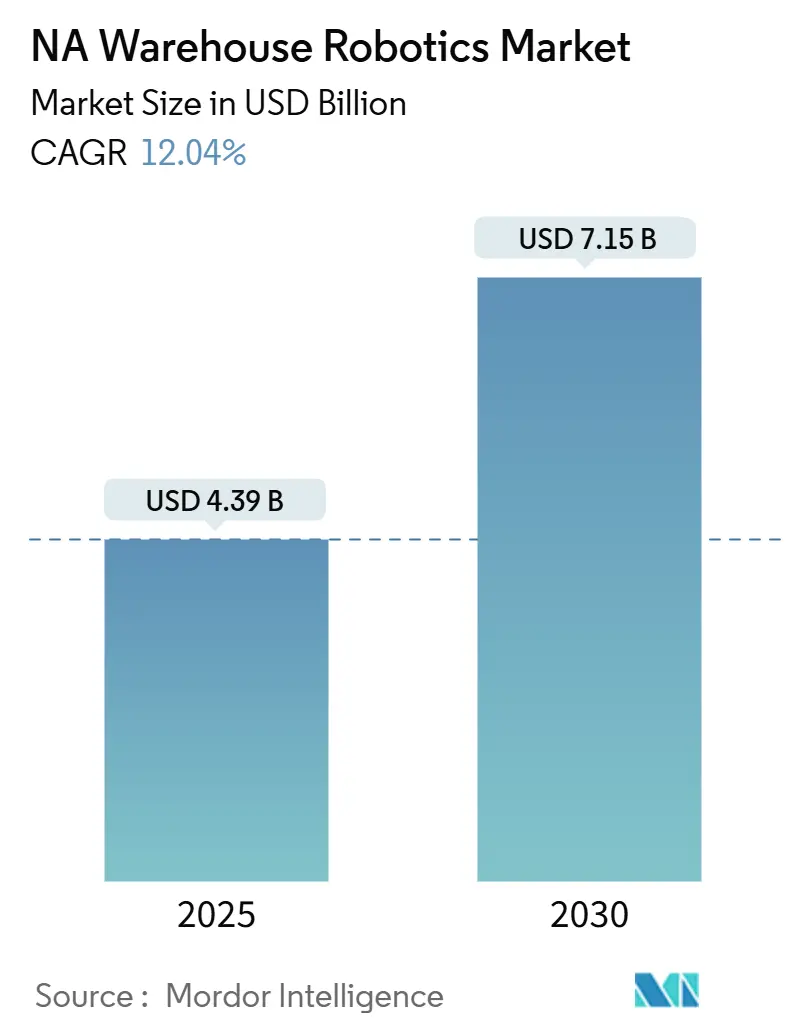
NA Warehouse Robotics Market Analysis by Mordor Intelligence
The NA Warehouse Robotics Market size is estimated at USD 4.39 billion in 2025, and is expected to reach USD 7.15 billion by 2030, at a CAGR of 12.04% during the forecast period (2025-2030).
- North American warehouses are rapidly automating, driven by surging e-commerce demands, labor shortages, and a push for streamlined supply chain operations. As e-commerce booms and 'on-demand' services evolve, warehouses are transforming into agile, 24/7 operations. With a dwindling workforce and rising online shopping demands, businesses are swiftly embracing robotics and automation.
- In the region, third-party logistics companies (3PLs) lag behind their retail and e-commerce counterparts in automation. However, they're poised for a technological leap to adeptly navigate global trade flows. The emergence of models like Robots-as-a-Service (RaaS) is easing the adoption of robotic systems in warehouses, primarily due to their lower upfront costs. Users now favor a subscription model over a substantial one-time payment, with fees based on metrics like picks per hour or processing volumes.
- Despite varied opinions on the U.S. economy, a clear trend emerges: after decades of offshoring for labor savings, manufacturing is making a significant comeback to the U.S. and North America. Influenced by geopolitical tensions, rising labor costs, and a cooling trade relationship with China, this shift is evident not only in the U.S. but also in Canada's and Mexico's manufacturing sectors. While a complete revitalization may take decades, the momentum is unmistakable.
- As manufacturing returns, sectors like artificial intelligence, automation, and robotics stand to gain significantly. AI, frequently in the limelight, is poised to enhance productivity and lessen reliance on manual labor. Innovations in "cobotics" or collaborative robotics are revolutionizing industries, spanning from manufacturing and fulfillment to human-centric services like medical and wellness care.
- Government initiatives championing Industry 4.0 are propelling the surge in warehouse automation. For instance, in June 2024, the U.S. government rolled out expanded grants for small and medium-sized manufacturers (SMMs) to adopt digital technologies. A significant portion of the Biden Administration’s USD 1.1 trillion funding, allocated for climate, infrastructure, semiconductors, and pandemic relief, has been directed towards modernizing manufacturing. This industrial revolution, blending digital technologies with physical systems, is guiding warehouses towards a smarter, more adaptable, and automated future.
- However, the path to warehouse automation is fraught with challenges. These include substantial initial investments, potential job displacements, and concerns about adaptability and maintenance. Moreover, a heightened reliance on technology introduces vulnerabilities, ranging from system malfunctions to cyber threats.
- Moreover, the evolving macroeconomic dynamics of the region are poised to create opportunities in the market under scrutiny. For instance, the recent US-China tensions have prompted a strategic pivot from the US government, now emphasizing the revival of its industrial and manufacturing sectors. This renewed focus is set to spur investments in fresh warehouses and distribution centers, which are critical for supporting supply chain operations. These facilities are expected to adopt advanced technologies, including robotics solutions, to enhance efficiency, reduce operational costs, and meet the growing demand for faster and more reliable logistics services, creating opportunities in the studied market.
NA Warehouse Robotics Market Trends and Insights
Retail Sector to Hold a Significant Market Share
- In recent years, retail e-commerce has surged dramatically. Responding to evolving consumer preferences, numerous companies have shifted from traditional brick-and-mortar outlets to online platforms, leveraging digital tools and strategies to enhance customer experiences and streamline operations.
- Data from Census.gov reveals that U.S. retail e-commerce sales for Q4 2024 reached USD 308.9 billion, a 2.7% uptick from Q3 2024. In the same quarter, total retail sales climbed to USD 1,883.3 billion, marking a 1.8% rise from the previous quarter. Year-over-year, Q4 2024's e-commerce sales surged 9.4% from Q4 2023, outpacing the 3.8% growth in total retail sales. This expanding retail landscape is prompting distribution centers to adopt innovative, flexible, and automated strategies for e-commerce order fulfillment, ensuring they can handle increasing order volumes while maintaining efficiency and accuracy.
- The incorporation of robots in retail e-commerce warehouses is revolutionizing the industry. E-commerce giants like Amazon, alongside emerging players, are increasingly turning to automation to meet the rising demands of online shopping. Robots, such as automated guided vehicles (AGVs) and robotic arms, now undertake tasks once reliant on human labor. They efficiently transport goods across vast warehouse spaces, retrieve items from shelves, and package orders for shipment. This shift to automation not only reduces human error and operational costs but also enhances throughput, meeting consumer demands for rapid deliveries. Additionally, the use of robotics allows companies to optimize warehouse layouts and improve inventory management, further driving operational efficiency.
- For example, in November 2024, Amazon introduced a suite of robots in its warehouses, highlighting boosts in efficiency and declines in employee injuries. Robotic arms, Robin and Cardinal, can lift packages up to 50 pounds. Another robot, Sparrow, moves items from bins to containers. Proteus, an autonomous mobile robot, traverses the warehouse, shifting carts. The humanoid robot, Digit, is being tested for moving empty totes, while Sequoia, a containerized storage system, presents totes to staff, reducing the need for stretching or squatting. These advancements underscore Amazon's commitment to leveraging cutting-edge technology to enhance warehouse operations and worker safety.
- As smart retail stores gain traction, the trend of automation and robotics in retail outlets and fulfillment centers is set to grow steadily, unveiling opportunities in the market. The integration of these technologies is expected to improve operational efficiency, enabling retailers to provide personalized and seamless shopping experiences, further driving customer satisfaction and loyalty.
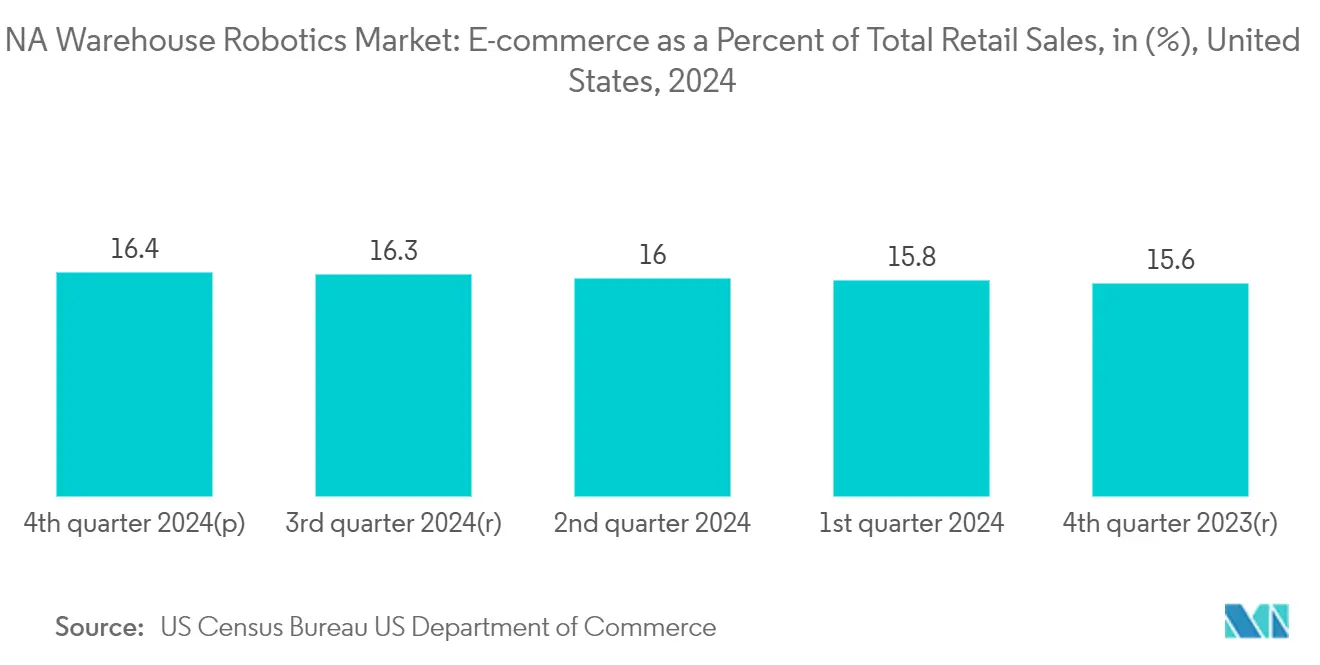
United States is Expected to Witness Significant Growth
- As e-commerce surges, U.S. warehouses and distribution centers increasingly deploy robots to enhance operational efficiency and meet growing consumer demands. Technological advancements have significantly improved robot efficiency and cost-effectiveness, enabling businesses to address regional labor shortages and streamline supply chain operations.
- Such demand has led to a notable increase in the need for equipment like palletizers, unit load AGVs, tug AGVs, and sortation systems, especially within food and beverage manufacturing. The implementation of stringent food safety rules and regulations and a rising preference for reduced human intervention in production processes further intensify this demand. These trends underscore the importance of automation in ensuring compliance and increasing operational efficiency in the food and beverage sector.
- The U.S. e-commerce landscape is thriving, with significant growth projected in 2024. According to the U.S. Census Bureau, e-commerce sales are set to reach USD 1,192.6 billion, marking an 8.1% rise from 2023. Concurrently, total retail sales for 2024 are projected to increase by 2.8%. E-commerce sales in 2024 will account for 16.1% of total sales, up from 15.3% in 2023. This expanding retail market drives distribution centers to adopt innovative, flexible, and automated strategies for order fulfillment, enabling them to handle increased order volumes efficiently and meet consumer expectations for faster delivery times.
- With a bolstering cold chain network, a flourishing e-commerce scene, and active trade in major U.S. markets, the warehouse robotics sector is poised for significant growth. Vendors are responding to this opportunity by increasing investments in product launches, forming strategic partnerships, and pursuing acquisitions to maintain a competitive edge. These initiatives aim to address the evolving requirements of industries driven by the growing demand for advanced robotics solutions in the U.S. market.
- As offline retail stores expand in the region, the warehouse industry reaps the benefits. More retail outlets mean a surge in demand for warehouse leasing and heightened inventory management. This growth is driven by the need for efficient storage solutions, streamlined supply chains, and quicker delivery times to meet consumer expectations. Take Target, for example. By the close of the 2024 financial year, this prominent North American retailer boasted 1,978 stores across the U.S., marking a 22-store increase from the previous year. This expansion highlights the growing footprint of offline retail, which directly influences the demand for warehousing facilities to support operations.
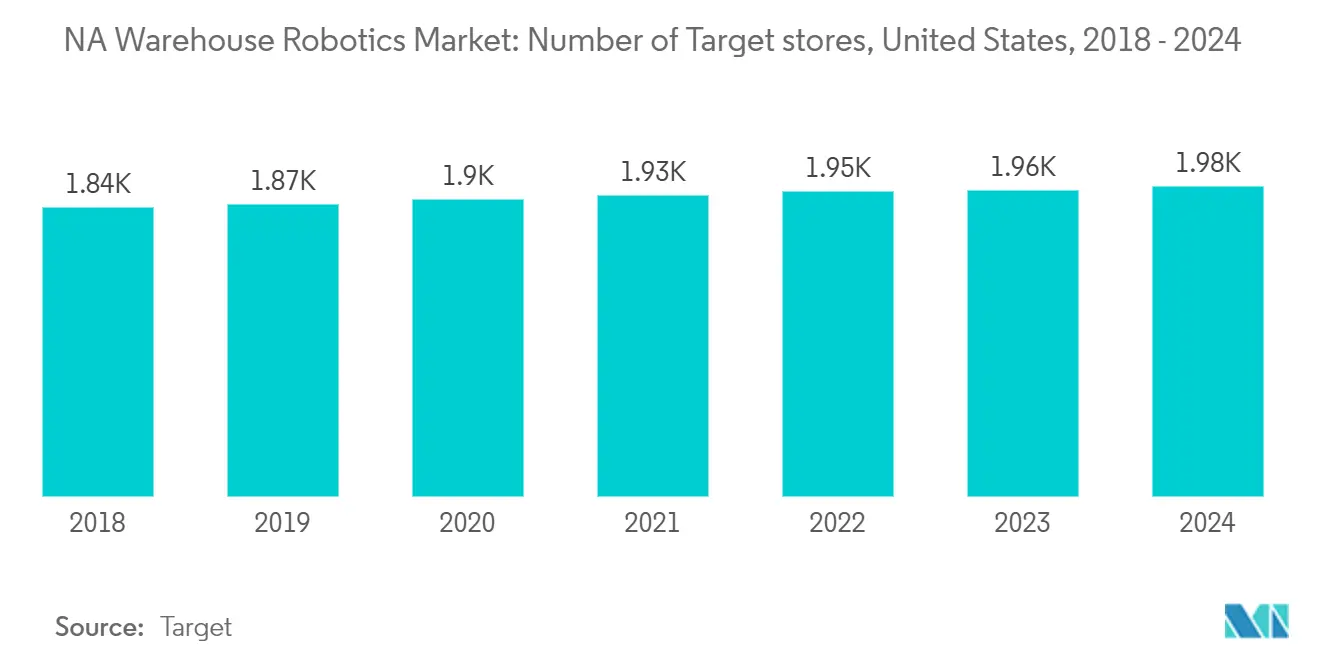
Competitive Landscape
The North American warehouse robotics market is semi-consolidated and consists of many competitive players. In terms of market presence, a few of the major players, such as Honeywell and Kiva Systems(Amazon Robotics LLC), currently dominate the market. These major players with a significant presence in the region and are expanding their customer base, and many companies are forming strategic and collaborative initiatives with various start-up companies to increase their market share and their profitability.
In light of the U.S. government's recent push to re-shore industrial facilities, investments in regional warehouses and distribution centers are set to rise. This trend is expected to create significant opportunities for market vendors to expand their operations and enhance their competitive positioning. As a result, market vendors should realign their strategies, emphasizing the development of innovative yet cost-effective products to cater to the growing demand. Additionally, tailoring solutions to meet the market's shifting demands will not only attract new customers but also bolster their market presence, enabling them to establish a stronger foothold in the evolving market landscape.
NA Warehouse Robotics Industry Leaders
-
Honeywell International Inc.
-
Omron Adept Technologies
-
Kiva Systems (Amazon Robotics LLC)
-
InVia Robotics Inc.
-
Locus Robotics
- *Disclaimer: Major Players sorted in no particular order
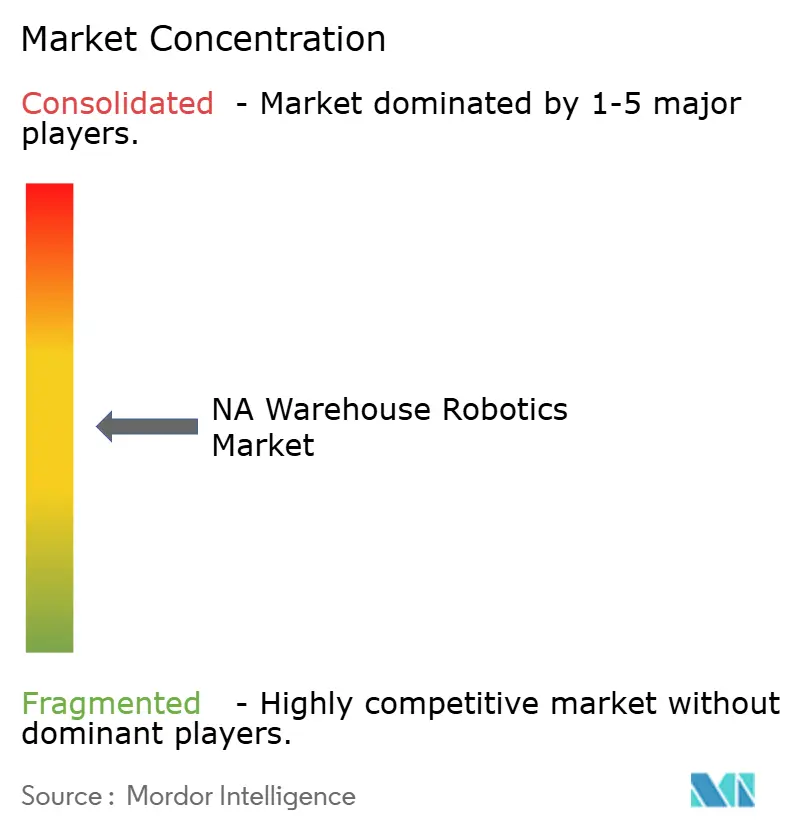
Recent Industry Developments
- March 2025: Agility Robotics recently showcased enhanced capabilities for Digit, broadening its utility for Agility's expanding clientele. These advancements were highlighted at ProMat, the foremost global event for the manufacturing and supply chain sectors. Real-world deployments are crucial for the mainstream acceptance of humanoid robots. Leading the charge, Agility Robotics boasts the industry's sole humanoid robot, Digit, actively deployed in warehouses and manufacturing sites. This distinct advantage enables Agility to work hand-in-hand with clients, rigorously testing, deploying, honing skills, and quantifying the robots' real-world value.
- March 2024: During the MODEX trade show in Atlanta, LG Business Solutions USA unveiled its warehousing autonomous mobile robots (AMRs) for the U.S. market. The company's CLOi CarryBot family, which made its debut in Asian markets in 2022, features two variants: the Mounting Type CLOi CarryBot and the Rolltainer Type CLOi CarryBot.
NA Warehouse Robotics Market Report Scope
Warehouse robotics refers to the usage of automated robots and specialized software that is used in the transportation of materials, performing various tasks, and streamlining or automating the whole warehouse process. In recent years, robotics has gained significant importance in the supply chain, distribution center, and warehouse management circles and continues to play a significant role in warehouse automation.
Key trends and dynamics driving the growth of North America's warehouse robotics industry are thoroughly analyzed in this study. Major market players' sales of warehouse robotics solutions in North America set the baseline for determining the market size. The study also examines significant macroeconomic factors, such as GDP growth, industrial automation trends, and labor market conditions, alongside other elements like technological advancements and regulatory frameworks, which collectively shape market dynamics.
The North American warehouse robotics market is segmented by type (conveyors & sortation systems, palletizers & de-palletizers, automated storage and retrieval system (ASRS), mobile robots, piece picking robots, and others), function(storage, packaging, and trans-shipments, other functions), end-user (food and beverage, automotive, retail, electrical and electronics, pharmaceuticals, other end-users), and country (United States, and Canada). The market sizes and forecasts are provided in terms of value in USD for all the above segments.
| Conveyors & Sortation Systems |
| Palletizers & De-Palletizers |
| Automated Storage and Retrieval System (ASRS) |
| Mobile Robots (AGVs and AMRs) |
| Piece Picking Robots |
| Others |
| Storage |
| Packaging |
| Trans-shipments |
| Other Functions |
| Food and Beverage |
| Automotive |
| Retail |
| Electrical and Electronics |
| Pharmaceutical |
| Other End Users |
| United States |
| Canada |
| By Type | Conveyors & Sortation Systems |
| Palletizers & De-Palletizers | |
| Automated Storage and Retrieval System (ASRS) | |
| Mobile Robots (AGVs and AMRs) | |
| Piece Picking Robots | |
| Others | |
| By Function | Storage |
| Packaging | |
| Trans-shipments | |
| Other Functions | |
| By End User | Food and Beverage |
| Automotive | |
| Retail | |
| Electrical and Electronics | |
| Pharmaceutical | |
| Other End Users | |
| By Country | United States |
| Canada |
Key Questions Answered in the Report
How big is the NA Warehouse Robotics Market?
The NA Warehouse Robotics Market size is expected to reach USD 4.39 billion in 2025 and grow at a CAGR of 12.04% to reach USD 7.15 billion by 2030.
What is the current NA Warehouse Robotics Market size?
In 2025, the NA Warehouse Robotics Market size is expected to reach USD 4.39 billion.
Who are the key players in NA Warehouse Robotics Market?
Honeywell International Inc., Omron Adept Technologies, Kiva Systems (Amazon Robotics LLC), InVia Robotics Inc. and Locus Robotics are the major companies operating in the NA Warehouse Robotics Market.
What years does this NA Warehouse Robotics Market cover, and what was the market size in 2024?
In 2024, the NA Warehouse Robotics Market size was estimated at USD 3.86 billion. The report covers the NA Warehouse Robotics Market historical market size for years: 2019, 2020, 2021, 2022, 2023 and 2024. The report also forecasts the NA Warehouse Robotics Market size for years: 2025, 2026, 2027, 2028, 2029 and 2030.
Page last updated on:
NA Warehouse Robotics Market Report
Statistics for the 2025 NA Warehouse Robotics market share, size and revenue growth rate, created by Mordor Intelligence™ Industry Reports. NA Warehouse Robotics analysis includes a market forecast outlook for 2025 to 2030 and historical overview. Get a sample of this industry analysis as a free report PDF download.
